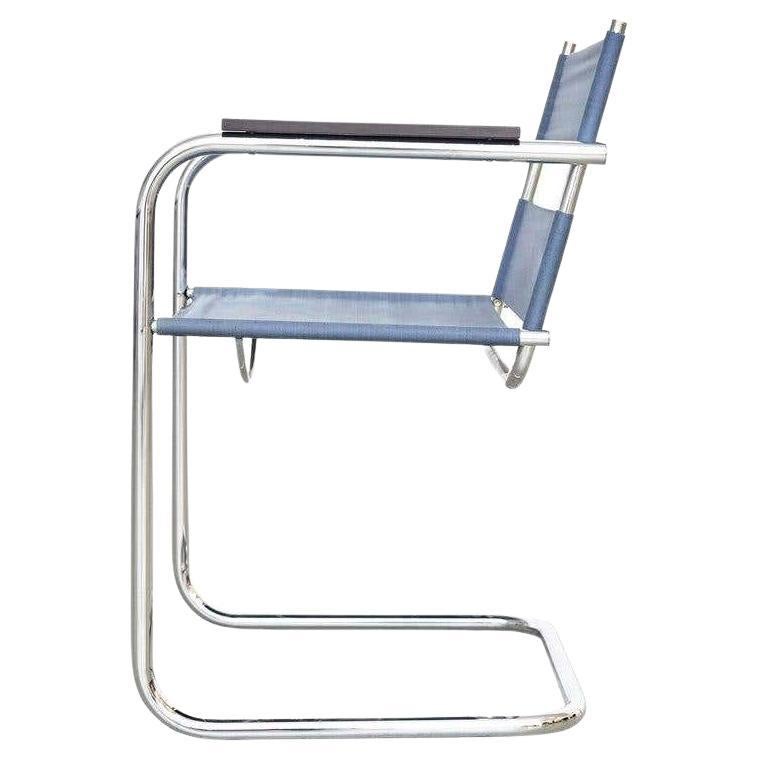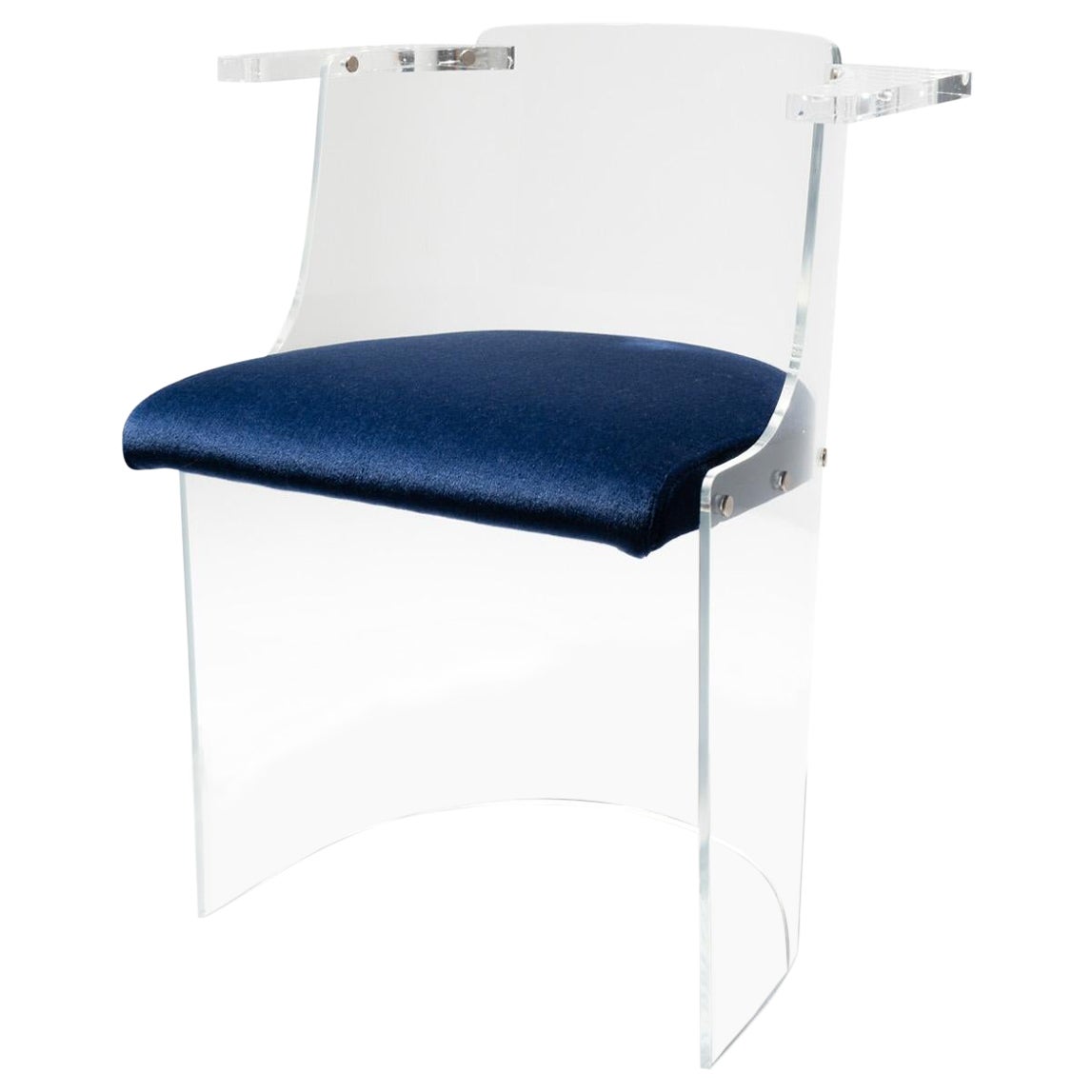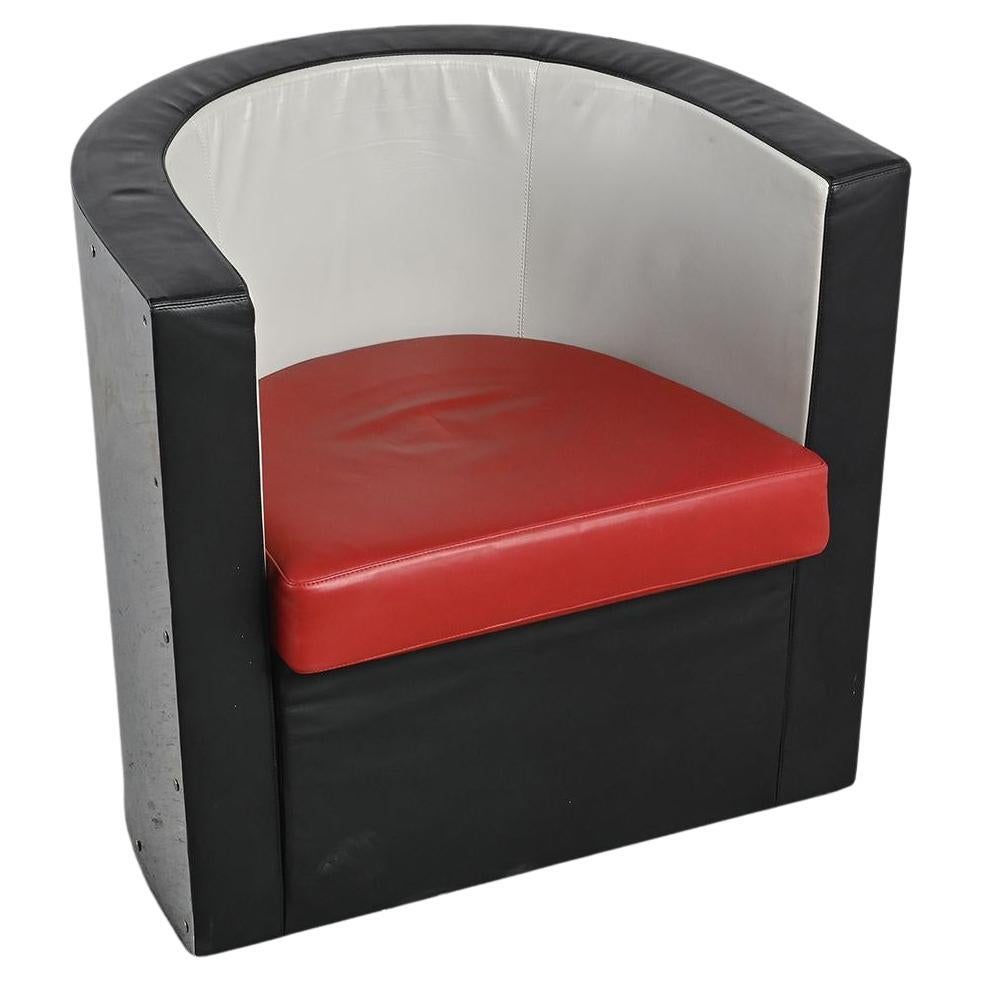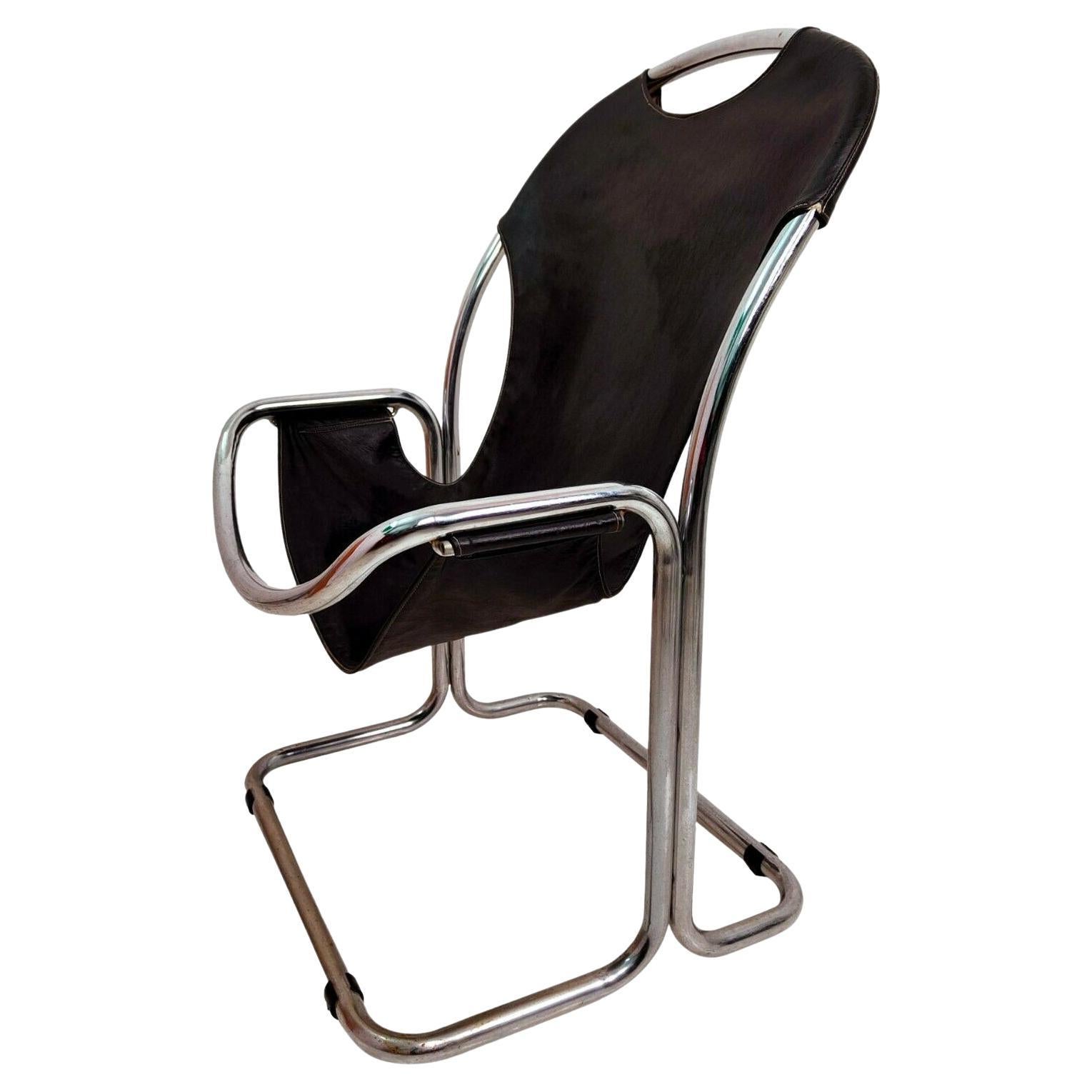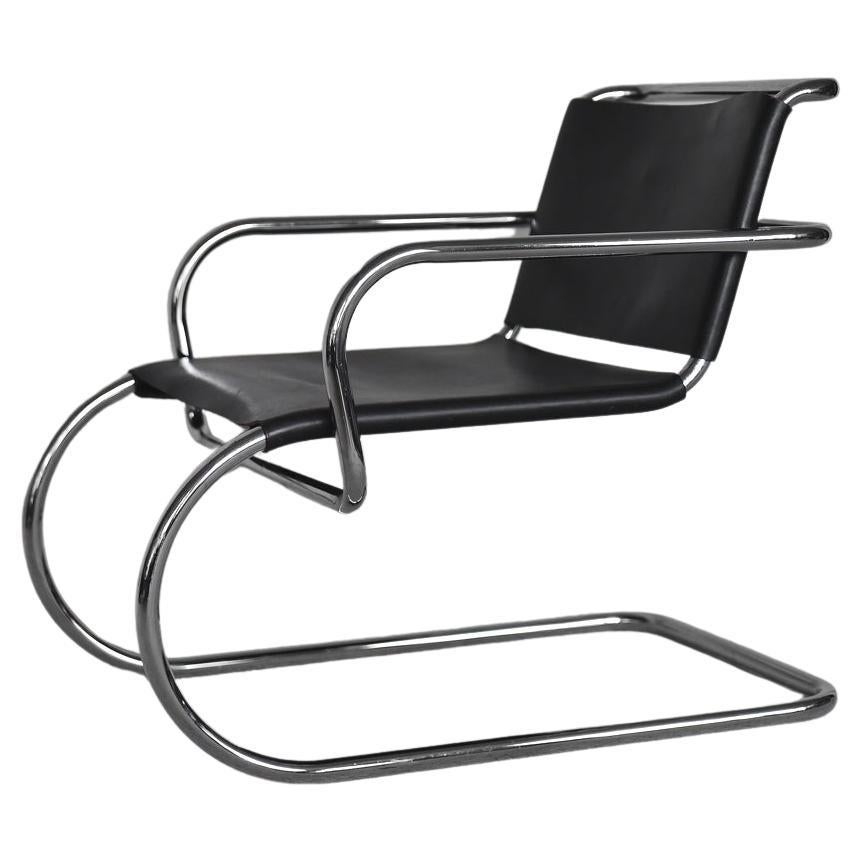Items Similar to El Lissitzky D61 Black and Blue Chair Bauhaus Style for Tecta, circa 1970
Want more images or videos?
Request additional images or videos from the seller
1 of 21
El Lissitzky D61 Black and Blue Chair Bauhaus Style for Tecta, circa 1970
About the Item
Chair model D61, designed by El Lissitzky in 1930.
Manufactured in Germany by Tecta, circa 1970.
In original condition, with minor wear consistent with age and use, preserving a beautiful patina.
Materials:
Wood
Leather
Dimensions:
D 51 cm x W 57 cm H 73 cm
El Lissitzky designed the portable plywood model D61 for the hygiene exhibition in Dresden. The exhibition was a specialty and went back to the director of the then Hygiene Museum. The aim was to record the contemporary problems of hygiene and to promote a health-oriented lifestyle.
Universal artist El Lissitzky (1890-1941) is one of the key protagonists of constructivism. The architect, photographer, designer, graphic artist and painter first studied architecture at Darmstadt Technical University (1909-1914) and in Moscow (1914-1918), and then followed Marc Chagall’s invitation to teach at Witebsk Art School, where he met Kazimir Malevich. Lissitzky liked to call himself a “constructor”.
- Creator:Tecta (Manufacturer),El Lissitzky (Designer)
- Dimensions:Height: 28.75 in (73 cm)Width: 22.45 in (57 cm)Depth: 20.08 in (51 cm)Seat Height: 17.52 in (44.5 cm)
- Style:Mid-Century Modern (In the Style Of)
- Materials and Techniques:
- Place of Origin:
- Period:
- Date of Manufacture:circa 1970
- Condition:Wear consistent with age and use.
- Seller Location:Barcelona, ES
- Reference Number:
About the Seller
4.9
Vetted Seller
These experienced sellers undergo a comprehensive evaluation by our team of in-house experts.
Established in 2015
1stDibs seller since 2015
1,635 sales on 1stDibs
Typical response time: 5 hours
- ShippingRetrieving quote...Ships From: Barcelona, Spain
- Return PolicyA return for this item may be initiated within 1 day of delivery.
More From This SellerView All
- Tecta Bauhaus Chair D 33Located in Barcelona, BarcelonaD33 armchair designed by unknown designer, circa 1960. Manufactured by Tecta. In good original condition, with minor wear consistent with age and use.Category
Vintage 1960s German Mid-Century Modern Armchairs
MaterialsSteel
- Mies Van Der Rohe B42 Rattan Easy Chair by Tecta, circa 1960By Ludwig Mies van der RoheLocated in Barcelona, BarcelonaThis MR10 chair designed by Ludwig Mies van der Rohe in 1927 is a true masterpiece of modern design. Manufactured by Tecta in Germany circa 1960, these chair are a testament to the e...Category
Vintage 1960s German Mid-Century Modern Chairs
MaterialsSteel
- Mies Van Der Rohe B42 Rattan Easy Chair by Tecta, circa 1960By Ludwig Mies van der RoheLocated in Barcelona, BarcelonaThis MR10 chair designed by Ludwig Mies van der Rohe in 1927 is a true masterpiece of modern design. Manufactured by Tecta in Germany circa 1960, these chair are a testament to the e...Category
Vintage 1960s German Mid-Century Modern Chairs
MaterialsSteel
- Gerrit Rietveld Zeilmaker Version of Black Red and Blue Chair by CassinaBy Cassina, Gerrit RietveldLocated in Barcelona, BarcelonaChair designed by Gerrit Rietveld in 1920. Relaunched in 2015. Manufactured by Cassina in Italy. One of the versions of the iconic model dated 1918. The structure is in black-stained beechwood with white contrasting parts. Seat and back in green lacquered multiplywood. The armchair can have a single seat and backrest cushion in fabric or leather. The black red and blue (Zeilmaker version) born from Rietveld’s chromatic experimentation While researching the origins of the red and blue model in collaboration with the Rietveld heirs, it emerged that the key idea of the first prototypes was based on the concept of spatial organization expressed through the monochrome tones of its elements. The first version was in fact produced in 1918 in completely unpainted wood. In the following years Rietveld proposed various examples, either monochrome or painted in different colors, depending on the requirements of his customers and the interiors for which the chairs were intended. As such, it comes as no surprise to find this 1920s version, presented as part of Cassina’s MutAzioni selection, created for the school teacher Wicher Zeilmaker with a black frame with white ends and a dark green painted seat and backrest. It was Rietveld’s ever-increasing involvement in the De Stijl movement that led him to also use primary colors on this model in 1923, and as such the chair became a veritable manifesto for the emerging neoplastic movement. Initially dubbed slat chair, Rietveld only gave it the name red and blue in the 1950s following its chromatic evolution. The various owners of the different examples used the chair as an abstract-realist sculpture in their interiors and, in some cases, as a simple tool for sitting on, adding cushions to make it more comfortable, just like Cassina offers for the black red and blue today. Production delay: 8-9 weeks Important information regarding images of products: Please note that some of the images show other colors and variations of the model, these images are only to present interior design proposals. The item that is selling is on the first image. Important information regarding color(s) of products: Actual colors may vary. This is due to the fact that every computer monitor, laptop, tablet and phone screen has a different capability to display colors and that everyone sees these colors differently. We try to edit our photos to show all of our products as life-like as possible, but please understand the actual color may vary slightly from your monitor About the designer: Gerrit Thomas Rietveld, born in Utrecht on 24 June 1888, seems possessed of two personalities, each so distinct that one might take his work to be that of more than one artist. The first personality is that seen in the craftsman cabinet-maker working in a primordial idiom, re-inventing chairs and other furniture as if no one had ever built them before him and following a structural code all of his own; the second is that of the architect working with elegant formulas, determined to drive home the rationalist and neoplastic message in the context of European architecture. The two activities alternate, overlap, and fuse in a perfect osmosis unfolding then into a logical sequence. In 1918 Rietveld joined the “De Stijl” movement which had sprung up around the review of that name founded the year before by Theo van Doesburg. The group assimilated and translated into ideology certain laws on the dynamic breakdown of compositions (carrying them to an extreme) that had already been expressed in painting by the cubists: the “De Stijl” artists also carefully studied the architectonic lesson taught by the great Frank Lloyd Wright, whose influence was widely felt in Europe at that time. Collaborating first with Robert van’t Hoff and Vilmos Huszar, then with Theo van Doesburg and Cornelius van Eesteren, Rietveld soon became one of the most distinguished interpreters of the neoplastic message. Among his most important works are: the Schröder house at Utrecht (1924); the “Row Houses” at Utrecht (1931-1934); the Dutch pavilion at the Venice Biennial (1954); the sculpture pavilion in the Rijksmuseum Kröller-Müller at Otterloo and the Van Gogh Museum in Amsterdam (1955). Out of his equally important furniture, Cassina has chosen for its own production: the “Red and Blue” (1918), the “Zig-Zag” (1934), the “Schröder 1...Category
2010s Italian Mid-Century Modern Armchairs
MaterialsWood, Leather
- Gerrit Rietveld Zeilmaker Version of Black Red and Blue Chair by CassinaBy Gerrit Rietveld, CassinaLocated in Barcelona, BarcelonaChair designed by Gerrit Rietveld in 1920. Relaunched in 2015. Manufactured by Cassina in Italy. One of the versions of the iconic model dated 1918. The structure is in black-stained beechwood with white contrasting parts. Seat and back in green lacquered multiplywood. The black red and blue (Zeilmaker version) born from Rietveld’s chromatic experimentation While researching the origins of the red and blue model in collaboration with the Rietveld heirs, it emerged that the key idea of the first prototypes was based on the concept of spatial organization expressed through the monochrome tones of its elements. The first version was in fact produced in 1918 in completely unpainted wood. In the following years Rietveld proposed various examples, either monochrome or painted in different colors, depending on the requirements of his customers and the interiors for which the chairs were intended. As such, it comes as no surprise to find this 1920s version, presented as part of Cassina’s MutAzioni selection, created for the school teacher Wicher Zeilmaker with a black frame with white ends and a dark green painted seat and backrest. It was Rietveld’s ever-increasing involvement in the De Stijl movement that led him to also use primary colors on this model in 1923, and as such the chair became a veritable manifesto for the emerging neoplastic movement. Initially dubbed slat chair, Rietveld only gave it the name red and blue in the 1950s following its chromatic evolution. The various owners of the different examples used the chair as an abstract-realist sculpture in their interiors and, in some cases, as a simple tool for sitting on, adding cushions to make it more comfortable, just like Cassina offers for the black red and blue today. Important information regarding images of products: Please note that some of the images show other colors and variations of the model, these images are only to present interior design proposals. The item that is selling is on the first image. Important information regarding color(s) of products: Actual colors may vary. This is due to the fact that every computer monitor, laptop, tablet and phone screen has a different capability to display colors and that everyone sees these colors differently. We try to edit our photos to show all of our products as life-like as possible, but please understand the actual color may vary slightly from your monitor About the designer: Gerrit Thomas Rietveld, born in Utrecht on 24 June 1888, seems possessed of two personalities, each so distinct that one might take his work to be that of more than one artist. The first personality is that seen in the craftsman cabinet-maker working in a primordial idiom, re-inventing chairs and other furniture as if no one had ever built them before him and following a structural code all of his own; the second is that of the architect working with elegant formulas, determined to drive home the rationalist and neoplastic message in the context of European architecture. The two activities alternate, overlap, and fuse in a perfect osmosis unfolding then into a logical sequence. In 1918 Rietveld joined the “De Stijl” movement which had sprung up around the review of that name founded the year before by Theo van Doesburg. The group assimilated and translated into ideology certain laws on the dynamic breakdown of compositions (carrying them to an extreme) that had already been expressed in painting by the cubists: the “De Stijl” artists also carefully studied the architectonic lesson taught by the great Frank Lloyd Wright, whose influence was widely felt in Europe at that time. Collaborating first with Robert van’t Hoff and Vilmos Huszar, then with Theo van Doesburg and Cornelius van Eesteren, Rietveld soon became one of the most distinguished interpreters of the neoplastic message. Among his most important works are: the Schröder house at Utrecht (1924); the “Row Houses” at Utrecht (1931-1934); the Dutch pavilion at the Venice Biennial (1954); the sculpture pavilion in the Rijksmuseum Kröller-Müller at Otterloo and the Van Gogh Museum in Amsterdam (1955). Out of his equally important furniture, Cassina has chosen for its own production: the “Red and Blue” (1918), the “Zig-Zag” (1934), the “Schröder 1...Category
2010s Italian Mid-Century Modern Armchairs
MaterialsLeather, Wood
- Gerrit Rietveld Zeilmaker Version of Black Red and Blue Chair by CassinaBy Gerrit Rietveld, CassinaLocated in Barcelona, BarcelonaChair designed by Gerrit Rietveld in 1920. Relaunched in 2015. Manufactured by Cassina in Italy. One of the versions of the iconic model dated 1918. The structure is in black-stained beechwood with white contrasting parts. Seat and back in green lacquered multiplywood. The armchair can have a single seat and backrest cushion in fabric or leather. The black red and blue (Zeilmaker version) born from Rietveld’s chromatic experimentation While researching the origins of the red and blue model in collaboration with the Rietveld heirs, it emerged that the key IDEA of the first prototypes was based on the concept of spatial organization expressed through the monochrome tones of its elements. The first version was in fact produced in 1918 in completely unpainted wood. In the following years Rietveld proposed various examples, either monochrome or painted in different colors, depending on the requirements of his customers and the interiors for which the chairs were intended. As such, it comes as no surprise to find this 1920s version, presented as part of Cassina’s MutAzioni selection, created for the school teacher Wicher Zeilmaker with a black frame with white ends and a dark green painted seat and backrest. It was Rietveld’s ever-increasing involvement in the De Stijl movement that led him to also use primary colors on this model in 1923, and as such the chair became a veritable manifesto for the emerging neoplastic movement. Initially dubbed slat chair, Rietveld only gave it the name red and blue in the 1950s following its chromatic evolution. The various owners of the different examples used the chair as an abstract-realist sculpture in their interiors and, in some cases, as a simple tool for sitting on, adding cushions to make it more comfortable, just like Cassina offers for the black red and blue today. Important information regarding images of products: Please note that some of the images show other colors and variations of the model, these images are only to present interior design proposals. The item that is selling is on the first image. Important information regarding color(s) of products: Actual colors may vary. This is due to the fact that every computer monitor, laptop, tablet and phone screen has a different capability to display colors and that everyone sees these colors differently. We try to edit our photos to show all of our products as life-like as possible, but please understand the actual color may vary slightly from your monitor About the designer: Gerrit Thomas Rietveld, born in Utrecht on 24 June 1888, seems possessed of two personalities, each so distinct that one might take his work to be that of more than one artist. The first personality is that seen in the craftsman cabinet-maker working in a primordial idiom, re-inventing chairs and other furniture as if no one had ever built them before him and following a structural code all of his own; the second is that of the architect working with elegant formulas, determined to drive home the rationalist and neoplastic message in the context of European architecture. The two activities alternate, overlap, and fuse in a perfect osmosis unfolding then into a logical sequence. In 1918 Rietveld joined the “De Stijl” movement which had sprung up around the review of that name founded the year before by Theo van Doesburg. The group assimilated and translated into ideology certain laws on the dynamic breakdown of compositions (carrying them to an extreme) that had already been expressed in painting by the cubists: the “De Stijl” artists also carefully studied the architectonic lesson taught by the great Frank Lloyd Wright, whose influence was widely felt in Europe at that time. Collaborating first with Robert van’t Hoff and Vilmos Huszar, then with Theo van Doesburg and Cornelius van Eesteren, Rietveld soon became one of the most distinguished interpreters of the neoplastic message. Among his most important works are: the Schröder house at Utrecht (1924); the “Row Houses” at Utrecht (1931-1934); the Dutch pavilion at the Venice Biennial (1954); the sculpture pavilion in the Rijksmuseum Kröller-Müller at Otterloo and the Van Gogh Museum in Amsterdam (1955). Out of his equally important furniture, Cassina has chosen for its own production: the “Red and Blue” (1918), the “Zig-Zag” (1934), the “Schröder 1...Category
2010s Italian Mid-Century Modern Armchairs
MaterialsLeather, Wood
You May Also Like
- D61 Chairs by El Lissitzky for Tecta Germany - 1980sBy El LissitzkyLocated in Renens, CHThe D61 Chair was originally designed by El Lissitzky for the 1930s Hygiene Exhibition in Dresden, Germany. Tecta re-issued this chair for a short period in the late 1970s -early 198...Category
Vintage 1970s German Mid-Century Modern Armchairs
MaterialsMohair, Wood, Plexiglass
- D62 Armchair by El Lissitzky, design 1928By El LissitzkyLocated in VILLEURBANNE, FRThe D62 armchair by El Lissitzky is an iconic piece of modern design. El Lissitzky, born Lazar Markovich Lissitzky, was a Russian artist, architect, and designer, a key figure in th...Category
Mid-20th Century German Mid-Century Modern Armchairs
MaterialsMetal
- Rattan MR Chair by Mies Van Der Rohe, Rare Elegant Tecta VariantBy Ludwig Mies van der RoheLocated in Grand Cayman, KYIconic Mid-Century Modern cantilever MR Chair by Mies Van Der Rohe in chromed bent tube steel and stunning original rattan weave. This beautiful example...Category
Mid-20th Century German Bauhaus Chairs
MaterialsMetal, Steel, Chrome
- Bauhaus Style Tubular Metal and Eco-Leather Collectible Chair, 1970sLocated in taranto, ITDesigner collection chair, clearly inspired by Bauhaus, made of chromed metal tubing, single sheet upholstery in black eco-leather It measures 90 cm in height, 56 cm...Category
Vintage 1970s Italian Bauhaus Chairs
MaterialsMetal
- Vintage Rare Bauhaus German Leather Armchair by Franco Albini for Tecta, 1950sBy Franco AlbiniLocated in Warszawa, MazowieckieThis exceptionally rare chair with arms was designed by Franco Albini in 1933 and produced by Tecta during the 1950s. The frame is made of tubular chrome-plated steel but the seat an...Category
Vintage 1950s German Bauhaus Armchairs
MaterialsChrome
- Hans Könecke for Tecta Lounge Chair in Brown SuedeBy Hans KöneckeLocated in Waalwijk, NLHans Könecke for Tecta, armchair, suede and metal, Germany, 1960s This lounge chair is another great example of German Modernist furniture, designed by architect Hans Könecke in the...Category
Vintage 1960s German Mid-Century Modern Lounge Chairs
MaterialsMetal
Recently Viewed
View AllMore Ways To Browse
1970 Blue Chair
Bauhaus Exhibition
Retro Directors Chair
School Style Chairs
Chair Black Leather Bauhaus
Blue Leather Chairs
Vintage Style School Chairs
Black Directors Chair
German School Chair
Wood School Chair Mid Century Modern
Contemporary Directors Chair
German Wood Leather Chair
German Plywood Chairs
Model 57
German Animal Skin Chairs
1941 Chair
Dresden Blue
Dresden Style
